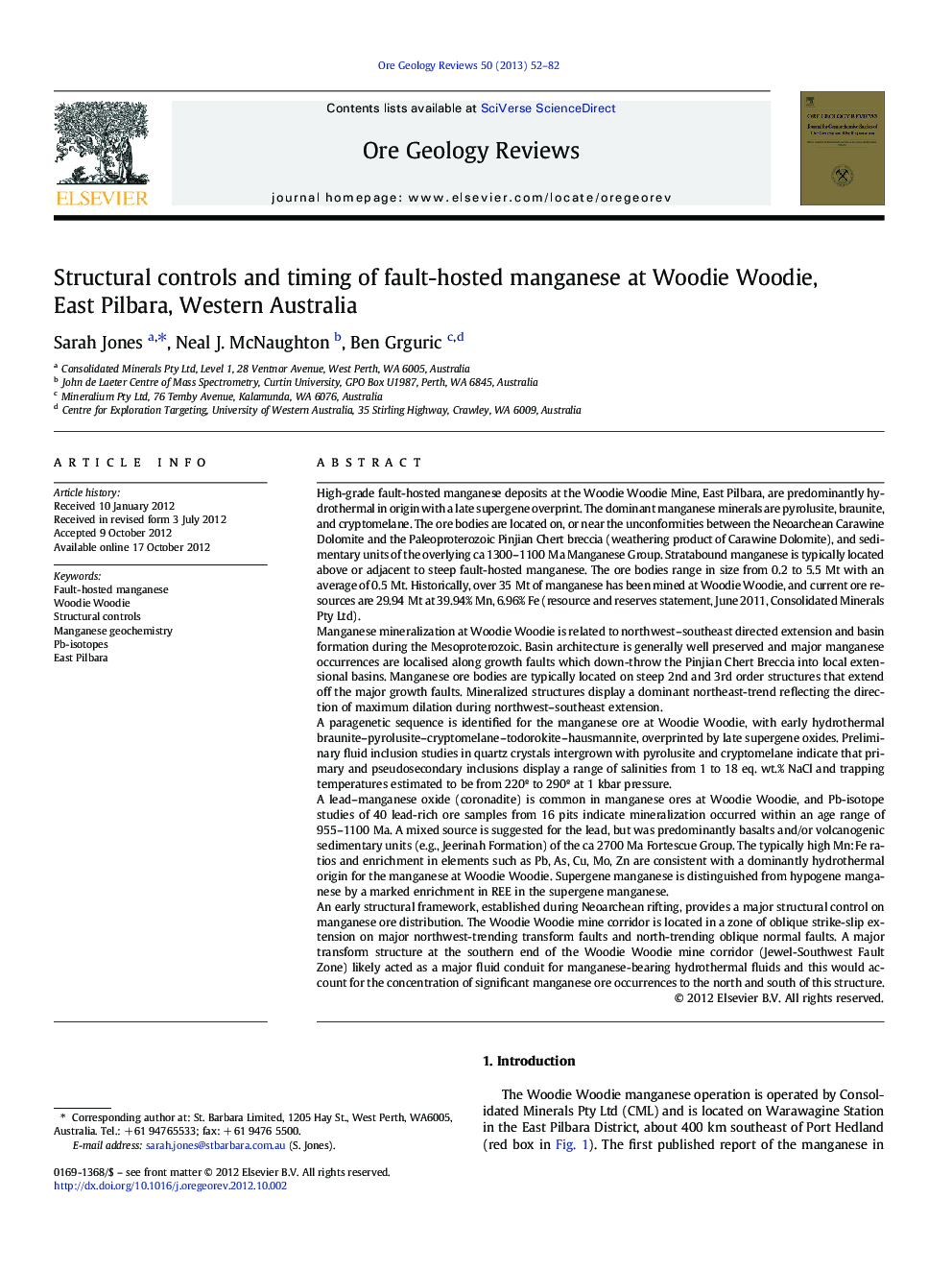| کد مقاله | کد نشریه | سال انتشار | مقاله انگلیسی | نسخه تمام متن |
|---|---|---|---|---|
| 4697580 | 1637253 | 2013 | 31 صفحه PDF | دانلود رایگان |
High-grade fault-hosted manganese deposits at the Woodie Woodie Mine, East Pilbara, are predominantly hydrothermal in origin with a late supergene overprint. The dominant manganese minerals are pyrolusite, braunite, and cryptomelane. The ore bodies are located on, or near the unconformities between the Neoarchean Carawine Dolomite and the Paleoproterozoic Pinjian Chert breccia (weathering product of Carawine Dolomite), and sedimentary units of the overlying ca 1300–1100 Ma Manganese Group. Stratabound manganese is typically located above or adjacent to steep fault-hosted manganese. The ore bodies range in size from 0.2 to 5.5 Mt with an average of 0.5 Mt. Historically, over 35 Mt of manganese has been mined at Woodie Woodie, and current ore resources are 29.94 Mt at 39.94% Mn, 6.96% Fe (resource and reserves statement, June 2011, Consolidated Minerals Pty Ltd).Manganese mineralization at Woodie Woodie is related to northwest–southeast directed extension and basin formation during the Mesoproterozoic. Basin architecture is generally well preserved and major manganese occurrences are localised along growth faults which down-throw the Pinjian Chert Breccia into local extensional basins. Manganese ore bodies are typically located on steep 2nd and 3rd order structures that extend off the major growth faults. Mineralized structures display a dominant northeast-trend reflecting the direction of maximum dilation during northwest–southeast extension.A paragenetic sequence is identified for the manganese ore at Woodie Woodie, with early hydrothermal braunite–pyrolusite–cryptomelane–todorokite–hausmannite, overprinted by late supergene oxides. Preliminary fluid inclusion studies in quartz crystals intergrown with pyrolusite and cryptomelane indicate that primary and pseudosecondary inclusions display a range of salinities from 1 to 18 eq. wt.% NaCl and trapping temperatures estimated to be from 220º to 290º at 1 kbar pressure.A lead–manganese oxide (coronadite) is common in manganese ores at Woodie Woodie, and Pb-isotope studies of 40 lead-rich ore samples from 16 pits indicate mineralization occurred within an age range of 955–1100 Ma. A mixed source is suggested for the lead, but was predominantly basalts and/or volcanogenic sedimentary units (e.g., Jeerinah Formation) of the ca 2700 Ma Fortescue Group. The typically high Mn:Fe ratios and enrichment in elements such as Pb, As, Cu, Mo, Zn are consistent with a dominantly hydrothermal origin for the manganese at Woodie Woodie. Supergene manganese is distinguished from hypogene manganese by a marked enrichment in REE in the supergene manganese.An early structural framework, established during Neoarchean rifting, provides a major structural control on manganese ore distribution. The Woodie Woodie mine corridor is located in a zone of oblique strike-slip extension on major northwest-trending transform faults and north-trending oblique normal faults. A major transform structure at the southern end of the Woodie Woodie mine corridor (Jewel-Southwest Fault Zone) likely acted as a major fluid conduit for manganese-bearing hydrothermal fluids and this would account for the concentration of significant manganese ore occurrences to the north and south of this structure.
► Mn at Woodie Woodie is hydrothermal in origin, with a late supergene overprint.
► Mn is deposited on extensional structures associated with local basin development.
► Timing of extension (c.900–100 Ma) based on field relationships and Pb-isotopes
► Mn is dominantly on steep NE-trending structures = maximum extension direction.
► Mn source is likely the underlying Archean basalts, not the Carawine Dolomite.
Journal: Ore Geology Reviews - Volume 50, February 2013, Pages 52–82
